Optimal Control Analysis of Smoking Dynamics Model With Cost-Effective Strategies
Abstract
In this work, we formulate and examine a mathematical model of cigarette smoking dynamics with optimal control theory. Firstly, we demonstrated that the solution of the model is a bounded region and nonnegative, which demonstrated that the model is well posed both mathematically and epidemiologically. Besides, we computed the cigarette smoking–free equilibrium and the endemic equilibrium points of the model. Then, the basic reproduction number was computed using the next-generation matrix, and the stability analysis of the equilibrium points was examined. The analysis shows that the cigarette smoking–free equilibrium point is stable over time if the basic reproduction number is less than one; otherwise, the model will reach the endemic equilibrium point. Also, a sensitivity analysis was conducted to assess the impact of key factors on cigarette smoking dynamics. Moreover, we extended the cigarette smoking dynamics model to an optimal control model via two controls: educating individuals and treating addicted smokers. Then, the existence of optimal controls is proven, and using Pontryagin’s minimum principle, the essential conditions of the optimal control model are examined. Also, if the resource is limited, a cost-effectiveness analysis is considered to identify the least costly strategies. Finally, the numerical simulation of optimality systems concluded that educating individuals to keep them away from the smoking addiction population is the most effective strategy to lessen the addiction of cigarette smoking.
1. Introduction
The act of smoking involves burning a cigarette and inhaling the smoke through your mouth, inhaling it into your lungs through pipes, and then letting it out. Numerous dangerous particles are present in cigarette smoke, and when smoking cigarettes, these particles can enter the body and cause harm [1]. Cigarette smoking is linked to several factors, such as age, peer pressure, peer smoking, parental smoking, parental socioeconomic status, family and friend attitudes, school-related issues, risky behaviors, lifestyle, stress, self-esteem, attitudes, and health concerns [2]. The study in [3] indicates that cigarette smoking is the primary cause of lung cancer. The most common cause of cancer-related deaths is lung cancer. So, 85% of lung cancer deaths are related to cigarette smoking. Smoking affects almost every organ in the body and causes several disorders. Approximately 6 million people die from cigarette smoking every year. Out of them, over 5 million people smoke, and over half do not smoke. According to the World Health Organization (WHO) report on the worldwide cigarette smoking epidemic, cigarette smoking–related deaths are rising annually. The tobacco industry has experienced significant expansion in recent decades, despite declining smoking rates in high-income countries. This growth has been driven by growing smoking in developing regions [4].
In epidemiology, mathematical modeling has proven to be a useful tool for comprehending and characterizing the dynamics of infectious illness [5]. Numerous mathematical studies have been carried out to better understand the reasons behind and strategies for preventing cigarette smoking around the world to decrease the number of both occasional and habitual smokers [6, 7]. For example, Castillo et al. [8] proposed the mathematical models for the dynamics of tobacco. The authors suggest that counseling efforts, or cultural immunization, create a class of individuals less likely to relapse and by no means susceptible. Sharomi and Gumel [9] developed a mathematical model of tobacco smoking dynamics and extended the work in [8] by adding a group of smokers who had temporarily stopped. The authors suggest that, regardless of how long mild smokers stayed in their class, the number of smokers in the community will be drastically decreased if chain smokers do not continue to smoke. Zaman [10] proposed a mathematical model for giving up smoking. According to their research, the strategy proposed will work with epidemic models other than the quitting smoking model. Lahrouz et al. [11] studied a deterministic mathematical model for smoking and extended it to a stochastic model by incorporating random noise. According to the authors, the size of the noise intensities and the model system’s parameters determine the stochastic stability of the current smoking equilibrium state. Fekede and Mebrate [12] proposed a mathematical model of secondhand smoking tobacco. The authors suggest that if the average number of smokers that a single addicted smoker produces is less than one, the population of secondhand smokers disappears over time; otherwise, the population of secondhand smokers persists.
Optimal control theory is a powerful mechanism that offers several efficient management ways to reduce or eliminate a community infection [13–15]. Several authors investigated an optimal control model to describe the role of control interventions on smoking dynamics. For example, Sun and Jia [16] developed optimal control of a delayed smoking model with immigration using two measures that control education campaigns and media campaigns for susceptible individuals and heavy smokers, respectively. Their study reveals that the combination of both is the best strategy for the elimination of susceptible individuals and heavy smokers. Nur [17] developed a mathematical modeling of the dynamics of smoking that includes optimum control interventions. The impact of control initiatives, such as treatment and prevention programs, on the dynamics of cigarette smoking in a community is then ascertained by the application of optimum control analysis. According to the study’s control, there is a rise in the population’s number of individual ex-smokers and a fall in the number of potential and current smokers. Omaret and Allali [18] developed an optimal control model by incorporating two control variables, namely, the government’s restriction on smoking in public places, while the second control represents the cost of cigarettes rising and an education campaign. The findings validate that the crucial function of control measures in diminishing the quantity of sporadic and habitual smokers potentially spares a noteworthy number of lives within the smoking community. Moreover, Liuyong et al. [19] presented the cigarette smoking dynamics with optimal control and analysis of cost-effectiveness. In their conclusion, the best, optimal, and least cost-effective controls to prevent tobacco use are the combination of media coverage and smoking cessation treatment.
However, all of these researchers did not consider an optimal control model via two controls: educating individuals and treating addicted smokers with cost-effective strategies. Hence, to fill this gap, we extended the cigarette smoking dynamics model in [9] to an optimal control model via two controls: educating individuals and treatment of addicted smokers. Besides, if the resource is limited, we considered a cost-effectiveness analysis to identify the most optimal and least costly strategies.
The remaining part is summarized as follows: The mathematical model framework for the spread of cigarette smoking is presented in Section 2. The stability of the endemic and cigarette smoking–free equilibria, as well as the positivity and boundedness of solutions, are examined in Section 3. The optimal control model for cigarette smoking dynamics is carried out analytically in Section 4 using the Pontryagin minimum principle. The topic of numerical simulation is covered in Section 5. Section 6 concludes with a statement.
2. Model Formulation
- 1.
Total population is assumed constant. Hence, migration and immigration factors are ignored.
- 2.
Population is mixing homogenously.
- 3.
Newborns are assumed to be susceptible.
- 4.
Recovered individuals are not permanently immune.
At a rate of π, the susceptible individuals are entering the population. The susceptible individuals become smokers either by smokers or addicted individuals with a force of infection β(S + τA), where β is the transmission rate and τ is the coefficient of transmission for the addiction to cigarette smoking. The addicted are more likely to infect others than smokers if τ > 1. Both smokers and addicts have an identical chance of infecting the susceptible if τ = 1; however, if τ < 1, smokers are more likely to infect the susceptible than addicts. Individual smokers progress at a rate of α to the addicted compartment with a probability of ρ, while the remaining individuals move to the recovery compartment with a probability of 1 − ρ via education or therapy. In other words, a population model of smoking dynamics must take into account the fact that millions of individuals die each year from smoking-related illnesses [2]. It is assumed that, in the addicted compartment, they have a higher probability of developing smoking-related illnesses in comparison to those in the smoker compartment. Addicted individuals move to either the recovered compartment at a rate of γ through education and/or treatment or pass away from their addiction at a rate of δ. The recovered people revert to susceptibility to smoking cigarettes at a rate of η. The natural death rate of individuals in each compartment is μ, and all the parameters are positive.

3. Model Analysis
In this section, we investigate the invariant region, positivity of the solution, disease-free equilibrium point, basic reproduction number, endemic equilibrium point, and local and global stability of equilibrium points of the system (1).
3.1. Invariant Region
To solve the cigarette smoking dynamics model (1), the invariant region must be biologically meaningful and mathematically well-posed, resulting in a bounded solution.
Theorem 1. The positively feasible set for system (1) is the closed region
Proof 1. We need to replace all of system (1)’s state equations and differentiate the population as a whole with regard to time in order to validate the theorem. The following outcomes emerge from this:
If there is no death due to cigarette smoking, then Equation (2) is reduced to . Resolving using the starting condition, we obtain
Evaluating Equation (3) as t⟶∞, we get T(t) ≤ π/μ, which implies that 0 ≤ T(t) ≤ π/μ. Hence, the feasible region of system (1) is
3.2. Positivity of the Solutions
In this subsection, we are going to show that all solutions of cigarette smoking dynamics model (1) with nonnegative initial data will remain nonnegative for all time t ≥ 0.
Theorem 2. For all future times, all of the solution sets N(t), S(t), A(t), and R(t) are nonnegative if N0 > 0, S0 ≥ 0, A0 ≥ 0, and R0 ≥ 0.
Proof 2. Let us use the first equation from system (1) in order to demonstrate this theorem:
This equation can be expressed without loss of generality, after eliminating the positive term (π + ηR), as an inequality
Then, solving Equation (5) using separation of variables, we get
Using the initial conditions, Equation (6) becomes
Given that the exponential function can never be negative, e−∫[β(S + τA) + μ]dt is a number that is not negative. Therefore, we can say that N(t) ≥ 0. Similar to this, we get
Equations (7) and (8) show that system (1) solution is nonnegative for any t ≥ 0. Thus, the region Ω in Equation (4) contains all of system (1)’s feasible solutions. As a result, the model has mathematical well-posedness and epidemiological significance.
3.3. Cigarette Smoking–Free Equilibrium
3.4. The Basic Reproductive Number
The average number of secondary cases that one main case in a fully vulnerable population generates is known as the basic reproduction number of cigarette smoking addiction. Hence, the first term gives the number of secondary infections produced by one smoker, and the second term gives the number of secondary infections produced by one addicted individual.
3.5. Stability Analysis of Cigarette Smoking–Free Equilibrium
Theorem 3. The cigarette smoking–free equilibrium point is locally asymptotically stable if and otherwise unstable.
Proof 3. We investigate the cigarette smoking addiction–free equilibrium points’ local stability using the Jacobean matrix. Using Equation (9), the Jacobian matrix of system (1) is
Expanding the determinant of by the first and last columns yields two eigenvalues of : λ1 = −μ < 0 and λ2 = −(η + μ) < 0. The last two eigenvalues are the eigenvalues of the next matrix:
The cigarette smoking addiction–free equilibrium point of system (1) is locally asymptotically stable if and . That is, from Equation (16), we have
Hence, from Equations (17) and (18), we have and if . Therefore, Ξ0 is locally asymptotically stable.
Theorem 4. If , system (1)’s equilibrium free from addiction to smoking cigarettes is globally asymptotically stable; if , it is unstable.
Proof 4. In order to demonstrate the smoking-free equilibrium point’s global stability, we build the Lyapunov function as L = c1S + c2A, where arbitrary constants are used. Then, differentiating with respect to time gives
Substituting the values of S′(t) and A′(t) from system (1) into Equation (19), we obtain
Putting c2 = −((βN − (α + μ))/ρα)c1. Then, from Equation (20), we get
Taking c1 = 1, then Equation (21) becomes
Thus, the trajectory of system (1) on which dL/dt = 0 if and only if A = 0, and dL/dt ≤ 0 for . This suggests that at Ξ0, the only dL/dt ≤ 0. According to Lasalle’s invariance principle, Ξ0 is thus globally asymptotically stable in Ω [24–26]. The fact that cigarette smoking is currently globally asymptotically stable indicates that a substantial and long-lasting decline in smoking rates throughout a population can be anticipated with the implementation of successful public health initiatives.
3.6. Endemic Equilibrium and Its Stability Analysis
Considering that (γ + δ + μ)(η + μ)2 is a strong positive term, (1 − ρ)α(γ + δ + μ) and γρα are comparatively smaller negative and positive terms, respectively. The denominator is positive because the strong positive factor dominates the impact of the smaller positive and negative terms taken together. The endemic equilibrium point expression’s denominator is therefore positive for appropriate parameter values and the common presumption that .
Theorem 5. For system (1), the endemic equilibrium point at Ξ∗ is locally asymptotically stable if .
Proof 5. To show the local stability of the endemic equilibrium point of system (1), we use the linearization approach. Thus, the Jacobian matrix becomes at the endemic equilibrium point
Additionally, at the endemic equilibrium point, the characteristic equation of the Jacobian matrix (Equation (23)) is provided by the following:
All roots of characteristic polynomials (Equation (24)) contain negative real portions according to the Routh–Hurwitz criterion if and only if Ψ1 > 0, Ψ2 > 0, Ψ3 > 0, Ψ4 > 0 and for the basic reproduction number in Equation (15) is greater than unity. Because of this, the endemic equilibrium is asymptotically stable locally.
Next, we want to demonstrate the globally asymptotically stable endemic equilibrium of the NSAR model. Combining the classical method of Lyapunov functions with Volterra–Lyapunov matrix features [27] can demonstrate global stability. First, we introduce relevant concepts and notations that will facilitate our global stability analysis [28].
Lemma 1 ([27, 29]). If there exists a positive diagonal matrix Dn×n > 0 such that DA + AtDt < 0 then An×n is Volterra–Lyapunov stable.
Lemma 2 ([27, 29]). If there exists the diagonal matrix Dn×n > 0 such that DA + AtDt > 0 then An×n is diagonally stable.
Proposition 1 ([27, 29]). The is Volterra–Lyapunov stable if and only if: a11 < 0, a22 < 0 and det(A) > 0.
Proposition 2 ([27, 29]). Let Dn×n = [dij] be a nonsingular matrix (n ≥ 2) and W = diag(m1, ⋯, mn) be a positive diagonal matrix. Let P = D−1. Then, if dnn > 0, and it is possible to choose mn such that WD + DtWt > 0.
To examine the global asymptotic stability of X, we show that the matrix M described in Equation (26) is Volterra–Lyapunov stable, or −M is diagonal stable. To accomplish this purpose, we prove the following lemmas.
Lemma 3. For the matrix M defined in Equation (26), let us consider , then D is diagonal stable.
Proof 6. From Equation (26), we have
To prove the diagonal stability of D, we must show that the three conditions listed below are met.
Condition 1. We demonstrate that the matrix is diagonally stable. To accomplish this, we first demonstrate that is Volterra–Lyapunov stable.
Clearly, and next we show , according to second equation of system (1), we have
Therefore, . Also, it is clear to see , since and . Therefore, is Volterra–Lyapunov stable.
Condition 2. We demonstrate that the matrix is diagonally stable. In fact, we show that is stable under Volterra–Lyapunov conditions.
According to Equation (1), we obtain
Multiplying Equation (28) by ρα, we get
From Equation (1), we have ραS∗ = (γ + δ + μ)A∗ and hence
By Equation (1), we have
Therefore, . Next, we want show that det(D) > 0. Then,
Hence, by Equation (29), det(D) > 0.
Condition 3. It is obvious that D33 > 0. Hence, is diagonally stable.
Lemma 4. The matrix is diagonally stable for matrix M.
Proof 7. By Proposition 2, one can derive the following conditions for proving the Volterra–Lyapunov stability of P, as follows:
- •
is diagonal stable,
- •
is diagonal stable,
- •
P33 > 0.
Let us delete the last row and last column of matrix −P and call it matrix . From Equation (25), it follows that
It is obvious that , , and . Therefore, is diagonally stable and Volterra–Lyapunov stable.
Our next goal here is to show that is Volterra–Lyapunov stable. Let us consider
It is easy to see that , , , and . Hence, is Volterra–Lyapunov stable.
Theorem 6. If , then the endemic equilibrium point of system 1 at Ξ∗ is globally asymptotically stable.
Proof 8. Based on Lemma 4, it concludes that there exists a positive diagonal matrix W such that WM + MtWt < 0. Therefore, when X ≠ X∗, and this ensures the global stability of the endemic equilibrium point. It implies that the endemic equilibrium of model system (1) is globally asymptotically stable.
3.7. Sensitivity Analysis
Sensitivity analysis is performed to determine system characteristics that could substantially impact . We calculated using [24, 25], which contains the specification of the normalized sensitivity index.
Definition 1. [25] When a variable depends differentiability on a parameter u, its normalized sensitivity index is defined as follows:
for u represents all the parameters in .
The findings showed that the parameters with a positive sensitivity index increased the value of the reproduction number as their values increased, while the other parameters remained constant.
Thus, the numerical values of the sensitivity indices of R0 to the model parameters are computed based on the parameter values in Table 1, and the results are displayed in Figure 2.
| Parameter | Sensitivity index |
|---|---|
| β | 1.0000 |
| π | 1.0000 |
| γ | −0.0657 |
| τ | 0.0128 |
| μ | −0.0068 |
| α | −0.0954 |

Based on the system parameters, sensitivity indices fall into two categories: positive and negative, as shown in Figure 2. A positive sign of the sensitivity index of to the system parameters has epidemiological implications because it means that changing any parameter in this category will result in an increase or decrease in the value, which in turn causes an increase or decrease in the burden of smokers in the interacting human populations. The community’s expansion of cigarette smoking is likely to be significantly influenced by the parameters with positive indices β, π, and τ if their values increase. Furthermore, the increasing values of the parameters μ, γ, and α, which have negative sensitivity indices, result in a decrease in the prevalence of tobacco usage within the society.
4. Optimal Control Model
4.1. Existence of Optimal Controls
We demonstrate in this section that there are such optimal control functions that, for the finite intervention period, minimize the cost function.
Theorem 7. A pair of optimal controls, , exists such that
Proof 9. We need to validate the following five terms in light of the findings in [20, 24] in order to demonstrate the existence of optimum controls triples.
- i.
The set of controls and associated state variables is not empty.
- ii.
A closed and convex measurable control set.
- iii.
The right side of the state system was bounded by a linearized function in the state and control variables that varied according to time and state variables.
- iv.
The cost-functional integrand, g(x, u), is convex on ϑ.
- v.
There are constants b1, b2 > 0 and b3>1 such that the integrand of the objective functional satisfies
- i.
Take note that the dynamics model (29) for cigarette smoking is bounded. It follows that the state system solutions (30) are bounded and continuous for all valid control functions in ϑ. Furthermore, the functions on the right side of the model Equation (30) satisfy the Lipschitz condition with respect to state variables. Consequently, the (Equation 30) solutions of the system are bounded. The set ϑ is therefore not empty.
- ii.
By definition, ϑ is closed since the control set ϑ = [0, 1]2. Additionally, for any two points y, z∈ϑ such that (z = (z1, z2) and y = y1, y2). According to Pang’s [19] definition of a convex set, λyi + (1 − λ)zi ∈ ϑi, for every λ ∈ [0, 1]. Hence, ϑi implies that λyi + (1 − λ)zi ∈ ϑ.
- iii.
In order to verify this condition, we used the approach adopted by [14]. Let the right hand side of the system (Equation 29) and its solution be represented by h and θ, respectively. It follows that
- i.
Hence,
- iv.
The integrand g(t, x, u) of the cost functional is given by
Let y = (y1, y2) and z = (z1, z2) ∈ ϑ and ϖ ∈ [0, 1]. Then, we have
Therefore,
- v.
Finally, we have
As a result, the objective function can be minimized by an ideal control. The proof is now complete.
4.2. The Hamiltonian and Optimality System
Theorem 8. For an optimal control set and that minimizes over U, there is an adjoint variables, λi, for i = 1, ⋯, 4 such that
Proof 10. We calculate the derivative of the Hamiltonian function () of Equation (32) with respect to N, S, A, and R, respectively, in order to determine the form of the adjoint equations. Next, the obtained adjoint or co-state equation is provided by
Obviously, after derivation of Hamiltonian () with respect to the controls the result becomes
If you solve for (u1, u2) it gives
The following results from the minimality criterion and boundedness on :
This completes the proof of the theorem.
5. Numerical Simulations
This section presents numerical solutions of system (1) and (30) for various model parameter values. It is demonstrated that the results of these simulations accord with the qualitative behavior of the system solutions. With N(0) = 155, S(0) = 150, A(0) = 10, R(0) = 43, to investigate how the factors affected the dynamics of cigarette smoking addiction, we performed a numerical simulation. We used various parameters with constant variables with varying initial values so that N + S + A + R. The average life expectancy in Ethiopia is 66.71 years; hence the natural death rate is calculated as μ = 1/(66.71 × 12) per day [30]. We provide a numerical example of the optimal control issue solution in system ref1 in this section. We employ the forward–backward sweep approach described in Lenhart and Workman’s book14 for this purpose. Using the parameter values listed in Table 2, Matlab software carried out numerical simulations of the models (1) and (29).
- 1.
Strategy 1: Teaching side effects of smoking cigarettes (u1 ≠ 0&u2 = 0),
- 2.
Strategy 2: Taking care of those with addictions (u1 = 0&u2 ≠ 0),
- 3.
Strategy 3: Combinations of two controls (u1 ≠ 0&u2 ≠ 0).
- 1.
Only teaching side effects of smoking cigarettes (u1 ≠ 0&u2 = 0)
- 2.
Taking care of those with addictions only (u1 = 0&u2 ≠ 0)
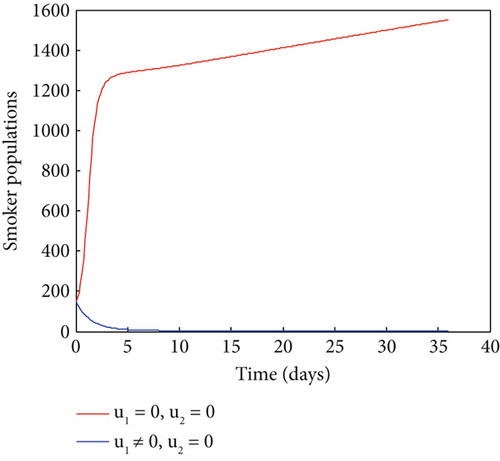
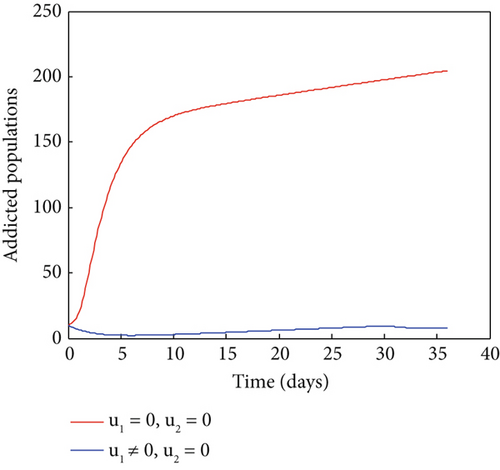
- 3.
Combinations of two controls (u1 ≠ 0&u2 ≠ 0)
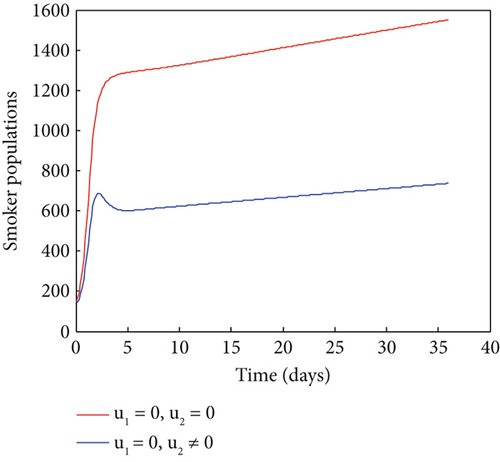
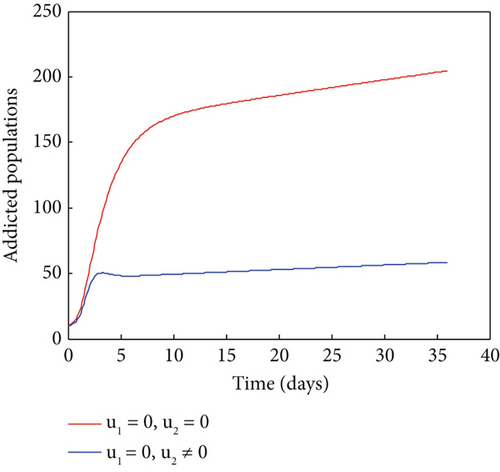
Lastly, we show the results of maximizing the goal function using the combined controls approach. In Figure 5, the related simulation results are displayed. This figure makes it clear that, in comparison to a situation where there is no control, the number of smokers and addicts has significantly decreased as a result of the control method. As a result, the intervention technique works to reduce the number of smokers and addicts within the designated time frame. Thus, in order to prevent addiction, policymakers may decide to employ this integrated strategy.
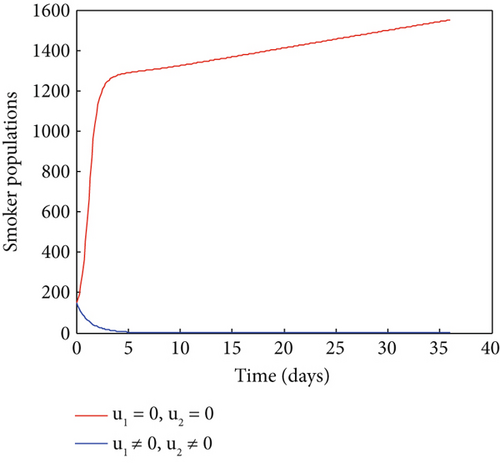
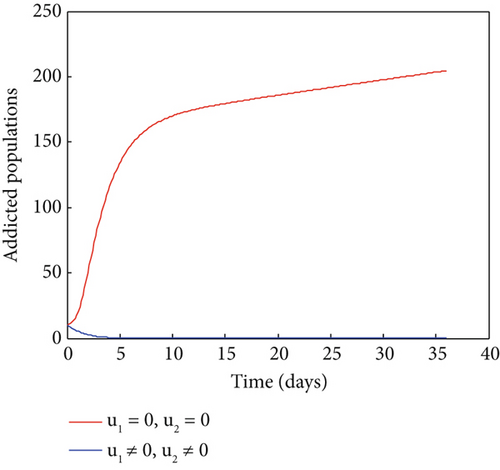
6. Cost-Effectiveness Analysis
In this subsection, we should design the best optimal and cheapest strategies for minimizing the cigarette smoking dynamics. This strategy was developed using the incremental cost-effectiveness ratio method (ICER). Besides, ICER can be expressed as the values obtained from the difference in averted costs between two strategies to the difference in the total number of infected averted [14]. The infected averted is calculated by the difference between the cigarette smoker using controls and the cigarette smoker if there are no controls, whereas the cost saved is computed by applying the cost functional given as and over time [24]. Therefore, the data we obtained in Table 3 was used to calculate the ICRE and obtain as written the following:
| Strategy | Description | Total of infected people | Dollars ($) |
|---|---|---|---|
| 1 | Prevention individuals | 3544.72 | 1411.30 |
| 2 | Treatment | 3692.54 | 2248.40 |
| 3 | Prevention and treatment | 5016.44 | 3256.62 |
Table 4 shows the number of infections averted with ICER for all strategies based on the results in Table 3.
| Strategy | Total of infected people | Dollars ($) | ICER |
|---|---|---|---|
| 1 | 3544.72 | 1411.30 | 0.398 |
| 2 | 3692.54 | 2248.40 | 5.662 |
| 3 | 5016.44 | 3256.62 | 0.761 |
Table 4 compares Interventions 1 and 2. The table shows that ICER (2) is higher than ICER (1). It implies Strategy 2 is expensive and unlikely to save lives. As shown in Figure 6, Strategy 1 saves more people than Strategy 2. Then, we removed 2 from the competing strategies. The ICER of Strategies 1 and 2 is then calculated, as indicated in Table 5.
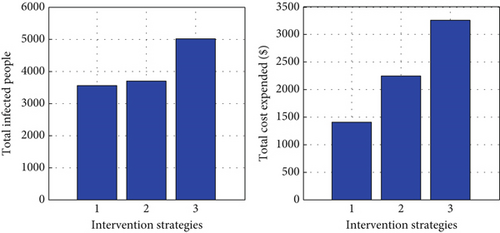
| Strategies | Total of infected people | Dollars ($) | ICER |
|---|---|---|---|
| 1 | 3544.72 | 1411.30 | 0.398 |
| 3 | 5016.44 | 3256.62 | 0.562 |
Table 5 compares the Interventions 1 and 3. From the table, we have seen that ICER (3) is higher than ICER (1). It implies Strategy 3 is more expensive. Consequently, we suggested that Strategy 3, which involves educating individuals to keep them away from the addicted population, is the optimal and cheapest intervention to minimize the smoking dynamics.
7. Conclusion
In this work, we developed and examined a mathematical model that captures cigarette smoking dynamics with optimal control and cost-effective strategies. Firstly, we show that the model’s solution is positive and bounded with the given initial conditions in a specific, meaningful set. This confirms the model’s well-posedness both mathematically and epidemiologically. Besides, we computed the model’s equilibrium points and demonstrated that they are both locally and globally asymptotically stable using the Jacobian matrix and Lyapunov functions, respectively. Also, we studies of the model’s sensitivity analysis of basic reproduction number have identified a parameter that has the most impact on the dynamics of smoking cigarettes. Furthermore, we extended the smoking dynamics model to the optimal control model involving two controls, such as teaching the public about the dangers of cigarette smoking to keep the susceptible humans away from addicts and treatment for the addicted population. Then, using Pontryagin’s minimum principle, the essential conditions of the optimal control model are examined. Then, we estimate the cost-effectiveness analysis utilizing the incremental ratio approach. Finally, our findings align with those of [19], indicating that educating the public about the risks of cigarette smoking and providing treatment is the most cost-effective approach. If there is a limited resource, our result suggested that a strategy that involves educating individuals to keep them away from the smoking addiction population is the most optimal and least costly intervention to minimize the smoking dynamics. In the future, we will propose considering calibrating the model to available data to estimate the model parameters and applying fractional calculus to the work to account for the memory effect in corruption dynamics. Moreover, the young researchers can expand on this study by including the stochastic model technique, individual age structure, environmental factors, and media roles.
Conflicts of Interest
The authors declare no conflicts of interest.
Author Contributions
Conceptualization, B.Z.A., D.E.T., and T.D.K.; validation, B.Z.A., T.D.K., and M.A.-a.; formal analysis, B.Z.A., D.E.T., T.D.K., and M.A.-a.; investigation, B.Z.A., T.D.K., and M.A.-a.; resources, B.Z.A., D.E.T., and M.A.-a.; data curation, B.Z.A., T.D.K., and M.A.-a.; writing—original draft preparation, B.Z.A., D.E.T., and T.D.K.; writing—review and editing, B.Z.A. and M.A.-a.; visualization, T.D.K. and M.A.-a.; supervision, T.D.K. and M.A.-a. All authors have read and agreed to the published version of the manuscript.
Funding
The authors declare that no financial support was received for the research, authorship, and/or publication of this article.
Open Research
Data Availability Statement
All data supporting the findings of this study are included within the article.




